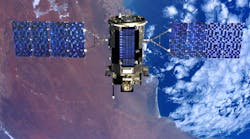When two forms of energy must coexist, some compromises are in order. Such is the case when microstrip antennas that communicate with electromagnetic (EM) energy must be designed and fabricated for use on CubeSat satellites that rely on solar panels to generate DC power from the sun’s solar radiation. To provide communications for CubeSat satellites, broadband antennas were designed at the Industrial-Scientific-Medical (ISM) frequencies of 434 MHz and 2.4 GHz by researchers working from several locations, including the University of Houston, NASA Johnson Space Center (Houston), and the Illinois Institute of Technology (Chicago). Two types of low-profile microstrip antennas were developed for the CubeSats: transparent antennas which are placed above the satellite’s solar panels, and nontransparent antennas which are placed below the solar panels.
Transparent antennas have been designed in different ways, typically through the use of transparent metal conductors or by fabricating an antenna from a conductive wire mesh which is mounted on a transparent substrate material, such as glass or quartz. Transparent metals like indium tin oxide have been used for antennas, although this particular metal has a high sheet resistance and yields relatively inefficient antennas. The use of meshed antenna structures, such as a silver epoxy mesh, has provided transparent antennas with better performance than those fabricated with transparent metal conductors—with relatively high efficiency and typically 90% transparency—meaning that 90% of the incident solar radiation is reaching the solar panels beneath the antenna.
To demonstrate the feasibility of using mesh microstrip circuit designs as transparent antennas for solar cells on satellites, a number of different transparent antennas were designed and fabricated, including a linearly polarized (LP) antenna with resonant frequency of 1.644 GHz for communication with the Iridium constellation of low-earth-orbit (LEO) satellites and a broadband circularly polarized antenna for use at 2.4 GHz. Both were based on transparent quartz substrates. The CP antenna was formed of two patch antennas formed on the diagonal plane of a quartz substrate measuring 76 × 100 × 2.25 mm. Circular polarization is obtained by using two nearly square LP patch antennas that are physically rotated 90 deg. from each other and fed signals that are 90 deg. out of phase from each other. Each patch antenna has a wide bandwidth so that the combination of the two patch antennas yields about a 4% bandwidth at 2.4 GHz.
The 90-deg. difference in the feed positions is achieved by means of a commercial 90-deg. quadrature hybrid coupler, which can be placed inside of the satellite to save space on the surface of the satellite and not interfere with the operation of the solar panels. Simulations with the High Frequency Structure Simulator (HFSS) EM simulation software from Keysight Technologies estimated a bandwidth of about 7.8% for the two-path mesh antenna design, from about 2.398 to 2.592 GHz. The mesh antenna achieves reasonable gain across that bandwidth while also reaching transparency of about 94% to allow the solar panels to operate with high efficiency.
The researchers also developed microstrip patch antennas that were more conventional, fabricated on standard high-frequency circuit materials such as Duroid. These antennas are not transparent, intended for mounting below the solar panels (known as subsolar antennas, versus supersolar antennas for placement above the solar panels). They faced the challenge of trying to design the antenna to cover as much as possible of the face of the CubeSat satellite, while also being resonant at a desired frequency such as 434 MHz or 2.4 GHz. Whether as supersolar or subsolar antennas, their designs show great promise for the coexistence of EM and solar energy in use on these miniature satellites.
See: “Transparent and Nontransparent Microstrip Antennas on a CubeSat,” IEEE Antennas & Propagation Magazine, Vol. 59, No. 2, April 2017, p. 58.

